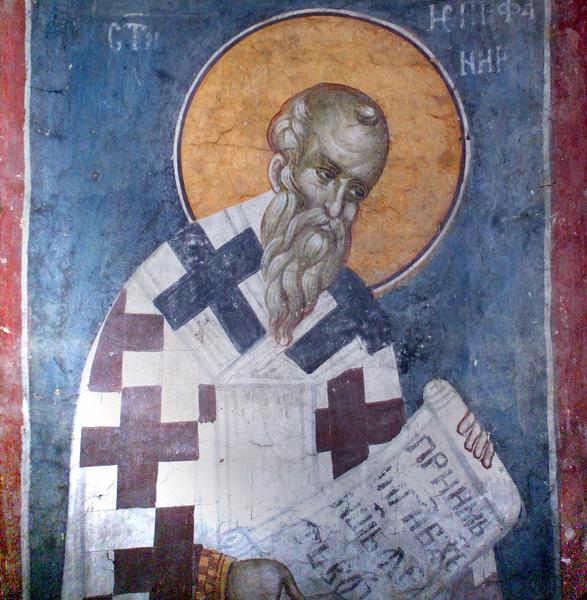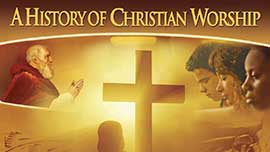EPIPHANIUS, ICONOCLAST AND CHURCH FATHER

[Above: Icon of St. Epiphanius, ironic given that he vehemently opposed icons!—fresco at Gracanica monastery, near Lipljan in Kosovo / public domain Wikimedia File:Epiphanius-Kosovo.jpg]
WHEN USE OF ICONS was creeping into the church, many Christians opposed them. In a famous instance, one bishop entered the church of Bethel in Judea, saw a curtain depicting a saint and ripped it down. That bishop was Epiphanius of Cyprus (also known as Epiphanius of Salamais).
Epiphanius hated heresy so much that he wrote two books against the spiritual errors of his day. In these he sought to establish the orthodox position against no fewer than eighty errors. He especially took to task false teachings about the Trinity and Resurrection. He had no use for Arianism, which denies the full divinity of Christ, or for Sabellianism, the teaching that God the Father, Son, and Holy Spirit are merely one person. (Orthodoxy teaches they are three persons in one Godhead.)
He wrote:
[T]he Father, the Son and the Holy Spirit are co-essential—three entities, one essence, one Godhead. This is the true faith which we have received from the ancients, the faith of the prophets, Gospels and apostles, which our fathers and bishops confessed when they met at the Council of Nicaea in the presence of the great and most blessed emperor, Constantine.
His first book was Ancoratus (The Well-Anchored) and was followed by a more extensive response to heresy, the Panarion (Medicine Chest). The first is especially interesting because it includes the baptismal creed his church used in Salamais. The second is invaluable because excerpts from it are often our only source of information regarding sects and people of the fourth century. It dealt with some heresies by hearsay, but it also provided historical background on heresies such as Arianism and Marcionism and on the teachings and scriptures of the Samaritans. Epiphanius also wrote an introduction to the Bible with a history of Scripture texts and some details of biblical archaeology.
Before bishops selected him to lead the church in Salamais, Epiphanius had been a monk given to strict ascetic practice. He was gifted with “wonderworking.” To escape attention, he went into the Spanidrion desert (Egypt). While a captive of bandits, he won one of their number to Christ. The man followed Epiphanius and recorded his life and miracles. After Epiphanius’s flight to the Pathysian desert (in Judea) to avoid being made bishop of Lycia, men came out to him in the wilderness and he established a monastery over which he presided for thirty years. Eventually he went to Cyprus, which happened to be in need of a bishop, and he was induced to accept the position. He was so famed that many outsiders sought his counsel.
Near the end of his life, Epiphanius was embroiled in controversy with the patriarchs John of Jerusalem and John Chrysostom, both of whom he accused of embracing errors found in Origen’s writings. He traveled to their sees to confront them in person. It was on his return voyage from visiting Chrysostom that he died. On this day, 12 May 403, the remains of Epiphanius were laid to rest in a new church he had built within his own see.
In 787, the Seventh Ecumenical Council authorized the use of icons. Despite Epiphanius’s opposition to them, the same council considered his writings of such worth it named him a father and teacher of the Church.
—Dan Graves
----- ----- -----
How has art and architecture been used in Christian worship? Watch A History of Christian Worship: Part 5, The Expression at RedeemTV
A History of Christian Worship - Part 5 - The Expression can be purchased at Vision Video.







